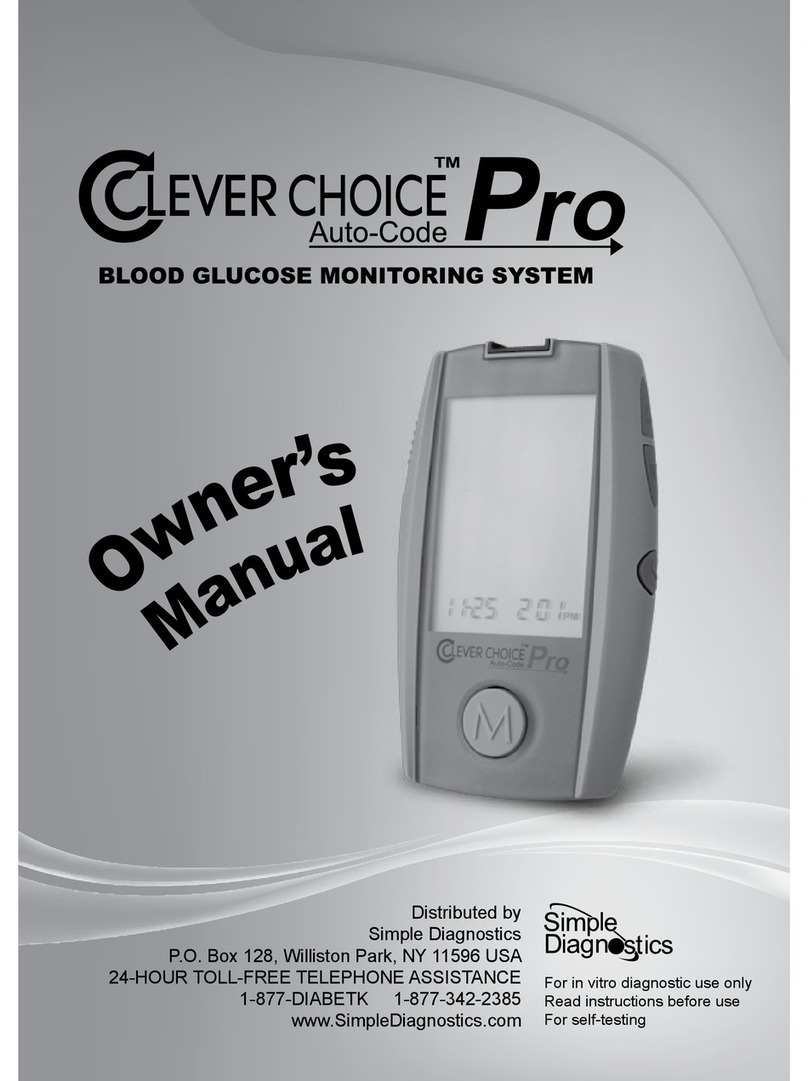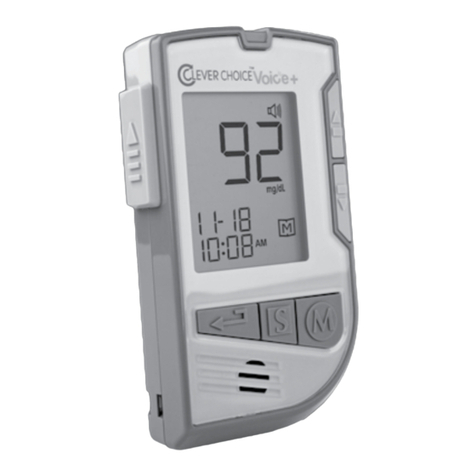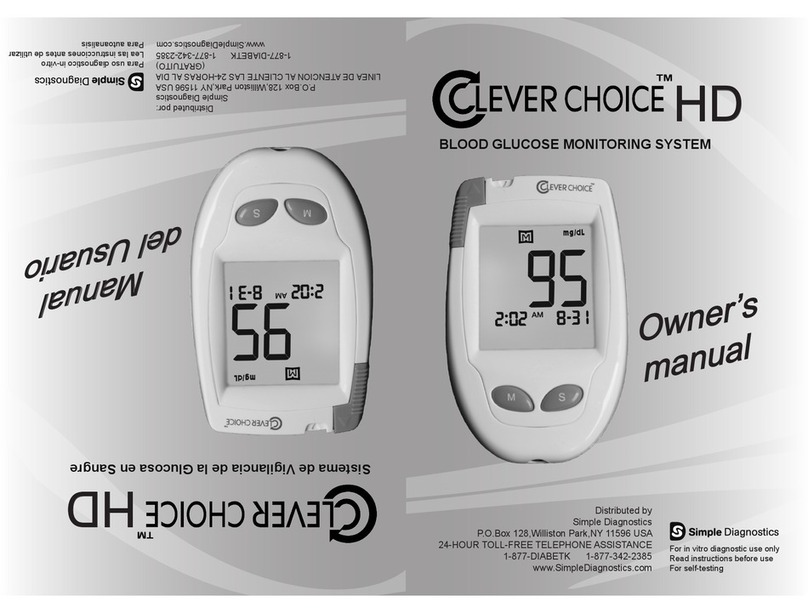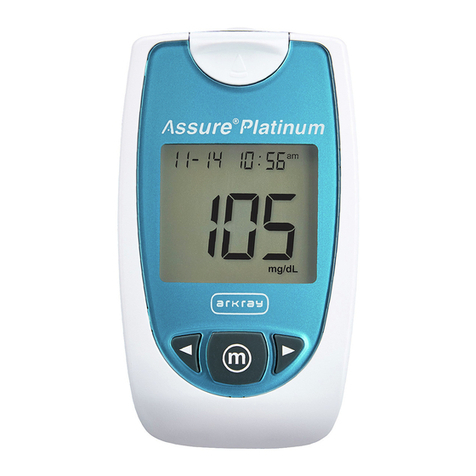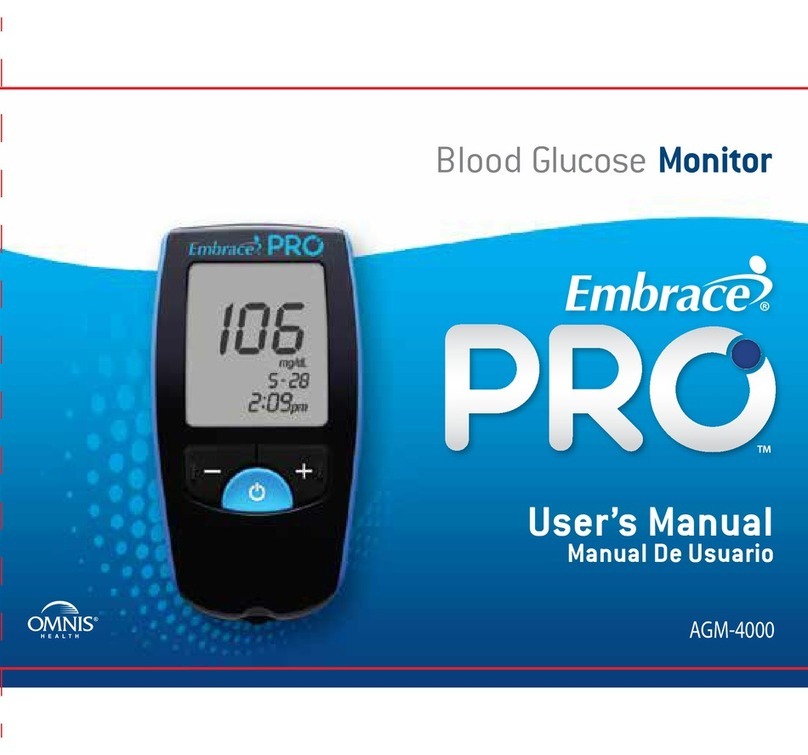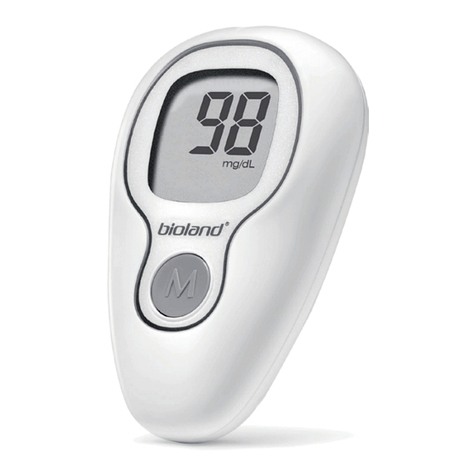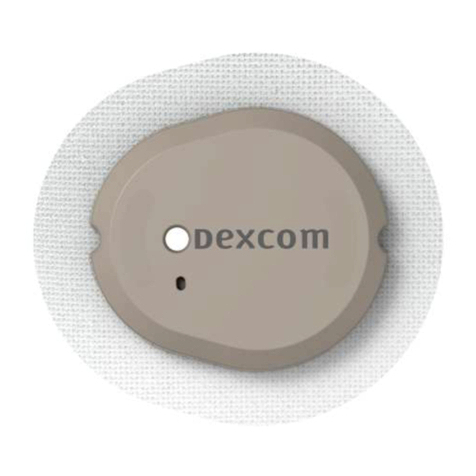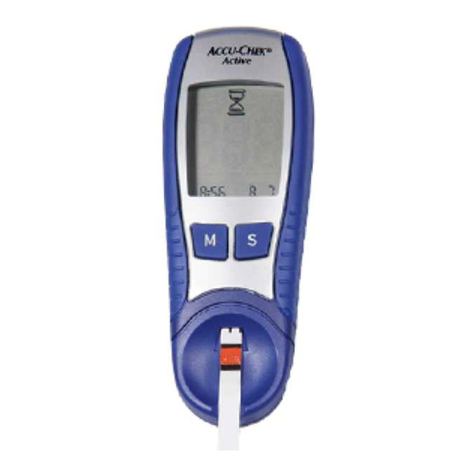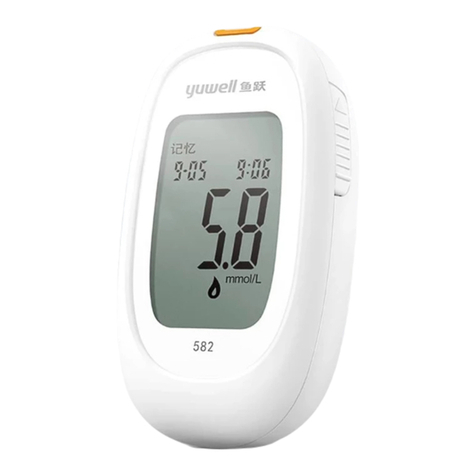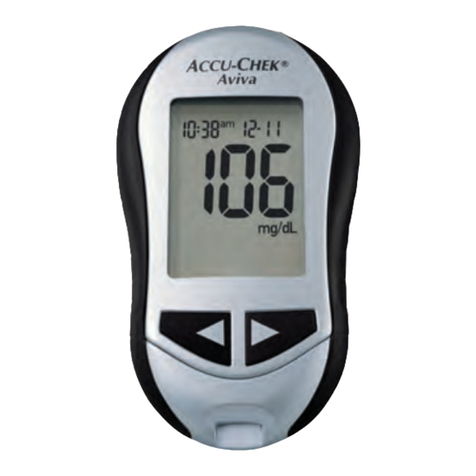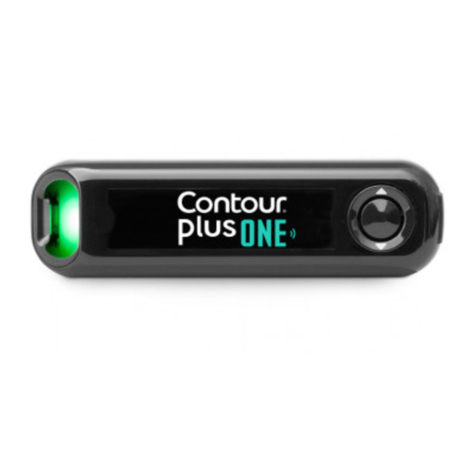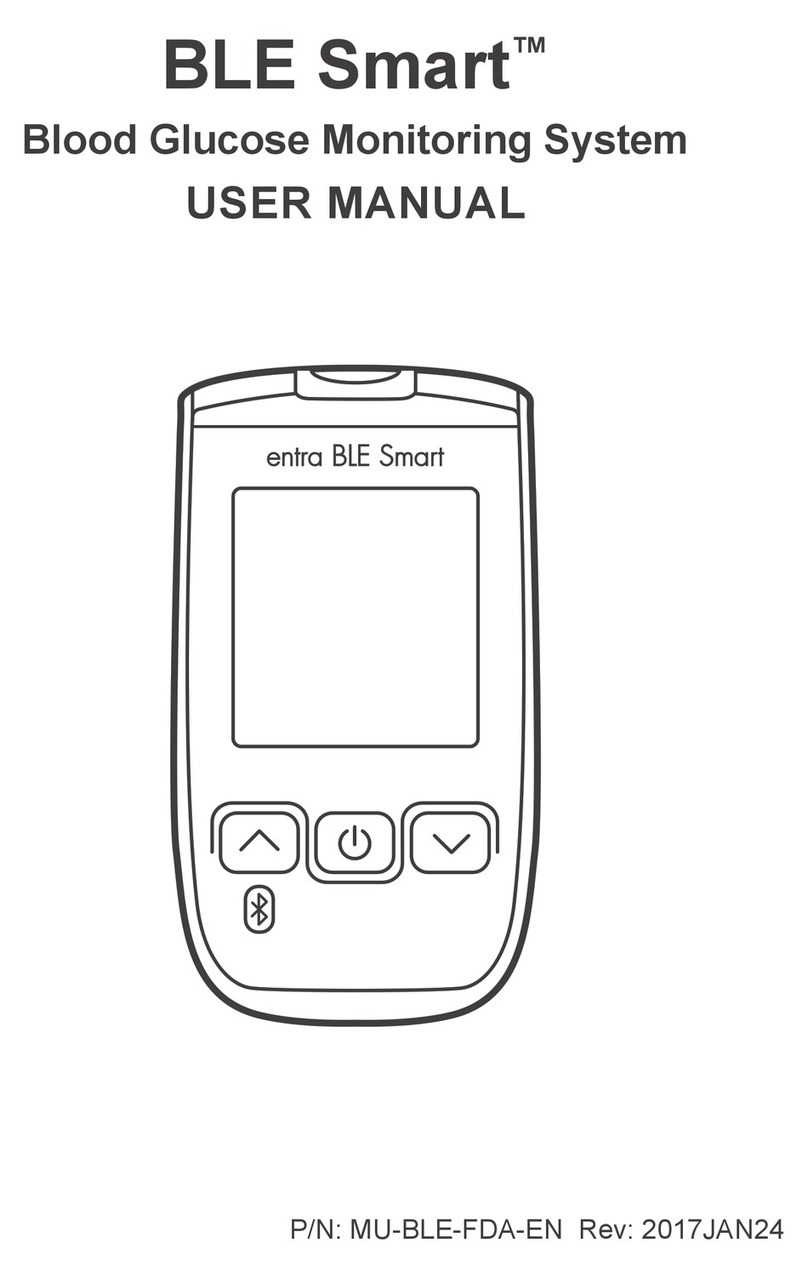Clever Choice Auto-Code Blood Glucose MonitoringSystem User manual

Ver 2.0
2008 07

2
Dear CLEVER CHOICE Auto-Code
System Owner:
Thanks for choosing CLEVER CHOICE Auto-Code Blood Glucose Moni-
toring System to manage your diabetes effectively. The greatest feature of
this system is its one code function which means you do not need to cali-
brate your meter, and makes you easily monitor blood glucose at home.
This manual contains important information that you must know about your
system. Please read it carefully and keep it for future reference.
For other questions regarding this system, please contact your local
customer service. At all other times, you should contact your health care
professional for assistance.

3
IMPORTANT SAFETY INSTRUCTIONS
READ THIS BEFORE USING
The following basic safety precautions should always be taken.
1. Close supervision is necessary when the device is used by, on, or near
children, handicapped persons or invalids.
2. Use the device only for the intended use described in this manual.
3. Do not use strips and control solutions which are not supplied by the
manufacturer.
4. Do not use the device if it is not working properly, or if it has suffered
any damage.
5. Before using any product to test your blood glucose, read all instructions
thoroughly and practice the test. Do all quality control checks as directed
and consult with a diabetes healthcare professional.
KEEP THESE INSTRUCTIONS

4
TABLE OF CONTENTS
IMPORTANT SAFETY INSTRUCTIONS 03
IMPORTANT INFORMATION 06
ABOUT ATERNATIVE SITE TESTING (AST) 07
INTRODUCTION OF THE SYSTEM 09
Intended Use 09
Principle of Measurement 09
Contents of the System 10
Appearance and Key Function of the Meter 11
Meter Display Segments 12
Appearance of the Test Strip 13
PREPARATION BEFORE USE 14
Battery Replacement 14
Setting the Meter and Deleting the Memory 16
BEFORE TESTING 20
Checking the Code Number 20
Checking the System with TaiDoc Control Solution 21
Important Control Solution Information 22
Doing a Control Solution Test 23
TESTING YOUR BLOOD 26
Testing Procedure 27
Expected Test Results 33
Special Messages 34
COMPARING METER AND LABORATORY RESULTS 35
USING THE METER MEMORY 37
CARING FOR YOUR METER AND STRIP 39

5
Cleaning 39
Storage 39
Strip storage 40
Control solution storage 41
PROBLEM-SOLVING GUIDE 42
Error Message 43
Problem in Operation 44
SPECIFICATIONS 46
SUMMARY OF OPERATION 47

6
IMPORTANT INFORMATION
Severe dehydration and excessive water loss may cause false low re-
sults. If you believe you are suffering from severe dehydration, consult a
healthcare professional immediately.
Test results below 60 mg/dL*1mean low blood glucose (hypoglycemia).
Test results greater than 240 mg/dL*2mean high blood glucose (hyper-
glycemia). If you get results below 60 mg/dL or above 240 mg/dL, and do
not have symptoms, rst repeat the test. If you have symptoms or con-
tinue to get results that fall below 60 mg/dL or above 240 mg/dL, follow
the treatment advice of your healthcare professional.
Apply only capillary whole blood sample to test your blood glucose. Ap-
plying other substances will cause wrong results.
If you are experiencing symptoms that are not consistent with your blood
glucose test results and you have followed all instructions described in
this owner’s manual, call your healthcare professional.
Inaccurate results may occur in severely hypotensive individuals or pa-
tients in shock. Inaccurate low results may occur for individuals expe-
riencing a hyperglycemic-hyperosmolar state, with or without ketosis.
Critically ill patients should not be tested with blood glucose meters.
Please refer to your test strip package insert for additional important
information.
*1: Kahn, R., and Weir, G.: Joslin’s Diabetes Mellitus, 13th ed. Philadelp
hia: Lea and Febiger (1994), 489.
*2: Krall, L.P., and Beaser, R.S.: Joslin Diabetes Manual. Philadelphia: Lea
and Febiger (1989), 261-263.

7
ABOUT ALTERNATIVE SITE TESTING (AST)
Important: There are limitations for doing AST.
Please consult your healthcare professional before you do AST.
What is AST?
Alternative site testing (AST) means
that people use parts of the body oth-
er than ngertips to check their blood
glucose levels. This system provides
you to test on the palm, the forearm,
the upper arm, the calf, or the thigh
with the equivalent results to ngertip
testing.
What’s the advantage?
Fingertips feel pain more readily be-
cause they are full of nerve endings
(receptors). At other body sites, since
nerve endings were not so condensed,
you will not feel as much pain as at the
ngertip.
When to use AST?
Food, medication, illness, stress and exercise can affect blood glucose
levels. Capillary blood at ngertip reects these changes faster than capil-
lary blood at other sites. Therefore when testing blood glucose during or
immediately after meal, physical exercise, or any other event, take blood
sample from your nger only.
We strongly recommend you do AST ONLY in the following intervals:
In a pre-meal or fasting state (more than 2 hours since the last meal).
Two hours or more after taking insulin.
Two hours or more after exercise.

8
Do NOT use AST if:
You think your blood glucose is low.
You are unawareness of hypoglycemia.
Your AST results do not match the way you feel.
You are testing for hyperglycemia.
Your routine glucose results are often uctuating.
You are pregnant.
How to increase the accuracy?
Stimulating blood perfusion by rubbing the puncture site prior to blood ex-
traction has a signicant inuence on the glucose value obtained. Blood
from the site without rubbing exhibits a measurably different glucose con-
centration than blood from the nger. When the puncture site was rubbed
prior to blood extraction, the difference was signicantly reduced.
Please follow suggestions below before getting a drop of
blood:
Rub the puncture site about 20 seconds before penetration.
Use a clear cap (included in the kit) instead while setting the lancing
device.

9
INTRODUCTION OF THE SYSTEM
Intended Use
The system is intended for use outside the body (in vitro diagnostic use).
It should be used only for testing glucose (sugar) and only with fresh capil-
lary whole blood samples taken from the nger and the alternative sites
including the palm, the forearm, the upper arm, the calf and the thigh. The
system is intended for use in the home and in clinical settings. It should not
be used for the diagnosis of diabetes or for the testing of newborns.
AST in this system can be used only during steady-state blood glucose
conditions described in the section of “About AST”.
Principle of Measurement
The test is based on the measurement of electrical current generated
by the reaction of glucose with the reagent of the strip. The meter mea-
sures the current and displays the corresponding blood glucose level. The
strength of the current produced by the reaction depends on the amount of
glucose in the blood sample.

10
Check your system to be sure that it is unopened prior to use
and that it contains all parts listed above. If either of these
conditions occurred, please return your system to the place
of purchase.
There are 3 levels for TaiDoc control solutions: low, normal and
high. Please note that TaiDoc control solutions are optional
and not included in the standard kit. Please ask your local
agent for availability.
PLEASE NOTE
Contents of the System
The system consists of three main products: the blood glucose meter, test
strips, and a vial of control solution. These products have been designed,
tested, and proven to work together as a system to produce accurate blood
glucose test results. Use only the same brand-name of test strips and
TaiDoc control solution with the blood glucose meter.
Your system includes:
jA meter oWarranty card
kSporty carrying case 10 Lancets
lDaily log book
mOwner’s manual
nYour rst time user guide

11
Appearance and Key Function of the Meter
TEST PORT
The test port is where you insert
the test strip for testing. The meter
will turn on automatically when you
insert a test strip.
DISPLAY
Your test results are displayed
here. The large, easy-to-read
display guides you through
the test using symbols and
simple messages.
SETTING BUTTON (in the back)
Setting the date, time and unit, located in
the battery compartment.
MAIN BUTTON
The main button in front of the meter
is used to set up the meter, enter the
memory mode, change the value of data
time, unit setting, memory deleting and
turn the meter on and off.

12
Meter Display Segments
CODE
Appears with the
code number
currently in use.
MEASUREMENT UNIT
TEST STRIP SYMBOL
Appears when the meter is on.
TEMPERATURE SYMBOL
Appears with ambient
temperature
after inserting a test strip.
BATTERY SYMBOL
Appears when the battery is low.
KETONE WARNING
When your blood glucose test
result is above 240mg/dL,
this symbol will appear with
display.
TEST RESULT AREA
Test results are displayed here.
BLOOD DROP SYMBOL
This symbol tells you when
to apply the sample.
DATE
TIME
MEM
Indicates a test result
stored in memory.
CTL SYMBOL
Appears when in control
solution test. Its result won't
be stored in the memory.
" ? " sign on the

13
Appearance of the Test Strip
Your system measures the amount of sugar (glucose) in whole blood.
Blood is applied to the absorbent hole of the test strip and is automatically
drawn into the reaction cell where the reaction takes place.
The test strip consists of the following parts:
Contact Bars
Insert this end of the test strip into the meter.
Push it in rmly until it will go no further.
Test Strip Handle
Hold this part to insert the test strip into the slot.
Conrmation Window
This is where you conrm if enough blood
Has been applied to the absorbent hole of the strip.
Absorbent Hole
Apply a drop of blood here,
The blood will be sucked automatically.
See pages 26~32, Testing Your Blood, for complete instructions.

14
PREPARATION BEFORE USE
Battery Replacement
Your meter comes with one 3.0 V (CR2032) lithium battery that is already
installed.
The meter will alert you when the power is getting low by displaying two
different messages:
Replacing the battery does not affect the meter’s memory (pre-
vious test results stored in memory). However, the time and
date settings may need to be updated.
Batteries might leak chemicals if not used for a long time. Re-
move the battery if you are not going to use the device for an
extended period (i.e., 3 months or more)
PLEASE NOTE
1. The symbol appears with “CHK” and
test strip symbol: the meter is func-
tional and the result remains accurate,
but it is time to change the battery.
2. The symbol appears with the ash-
ing E-b symbol: the battery can not
provide enough power to do a test.
You must change the battery imme-
diately.

15
To replace the battery, make sure that the meter is turned off.
1. Press the buckle on battery cover and lift up to remove cover.
2. Remove the old battery and replace with one new 3.0 V (CR2032) lithi-
um battery. Make sure that the positive “+” side is facing up.
3. Close the battery cover. If the battery is inserted correctly, you will hear
a “beep”.
As with all small batteries, the batteries should be kept away from
small children who still put things in their mouths. If they are swal-
lowed, promptly see a doctor for help.
WARNING
13
2

16
Setting the Meter and Deleting the Memory
Your meter comes with the time, date and unit of temperature preset. But if
you replace the battery, you may need to reset the meter.
Start with the meter off. Then press the
set button located in the battery com-
partment. The meter is now in the setting
mode. You can start to set up the meter.
STEP 1 Set the Year
The year will appear rst, with the year set-
ting ashing. Press and release the Main
button to advance one year. To move faster,
keep pressing the Main button until the de-
sired number appears. With the correct year
on the display, press the Set button and then
the month segment ashes.
STEP 2 Set the Month
Press and release the Main button until
the correct month appears. To move faster,
hold the Main button down. With the correct
month on the display, press the Set button
and then the day segment ashes.
STEP 3 Set the Day
Press and release the Main button until the
correct day appears. To move faster, hold
the Main button down. With the correct day
on the display, press the Set button and then
the hour segment ashes.

17
STEP 4 Set the Hour
Press and release the Main button to ad-
vance one hour. To move faster, hold the
Main button down. With the correct hour on
the display, press the Set button and then
the minute segment ashes.
STEP 5 Set the Minutes
Press and release the Main button to ad-
vance one minute. To move faster, hold the
Main button down. With the correct minute
on the display, press the Set button and
then the current unit of measurement starts
ashing.
STEP 6 Select ºF or ºC
Press and release the Main button to select
the unit of temperature you want to use.
Press the Set button and the meter will dis-
play “dEL” with ashing “mem” symbol.

18
STEP 7 Delete Memory and Exit the Setting Mode
With “dEL” and ashing “mem” symbol on the dis-
play:
Press the Main button again to delete all of the memory, following the
meter will display “---“ and “OK” to show that the memory is deleted. Then
press the Set button to turn off the meter.
If you do not want to delete the memory, press the Set button to skip this
step and then the meter will be turned off.
Congratulations! You have nished all settings now!

19
The time, date and unit of temperature can ONLY be changed in the
setting mode. Therefore, when you perform a glucose testing, those
parameters are not possible to be changed.
Your meter displays 7-, 14-, 21-, 28-, 60- and 90-day averages which
you can access from the meter memory. These averages are cal-
culated from results obtained during the 7-, 14-, 21-, 28-, 60- and
90-day preceding the current date and time settings. When the date
and time are changed, the 7-, 14-, 21-, 28-, 60- and 90-day averages
may change.
While the meter is in the Setting mode, it will turn off automatically
without any action in one minute.
PLEASE NOTE

20
BEFORE TESTING
Checking the Code Number
This system provides you One Code function. You do not have to cali-
brate the meter when you use a new vial of test strips. You just need to
make sure that the code number on the test strip vial is “9F” before you
proceed.
Please note that CLEVER CHOICE Auto-Code system only works with
“9F” code number. If the code number on the test strip vial is not “9F”,
please stop testing and contact your local agent for help. Failure to do so
will get the wrong result.
9F
This manual suits for next models
1
Table of contents
Other Clever Choice Blood Glucose Meter manuals
